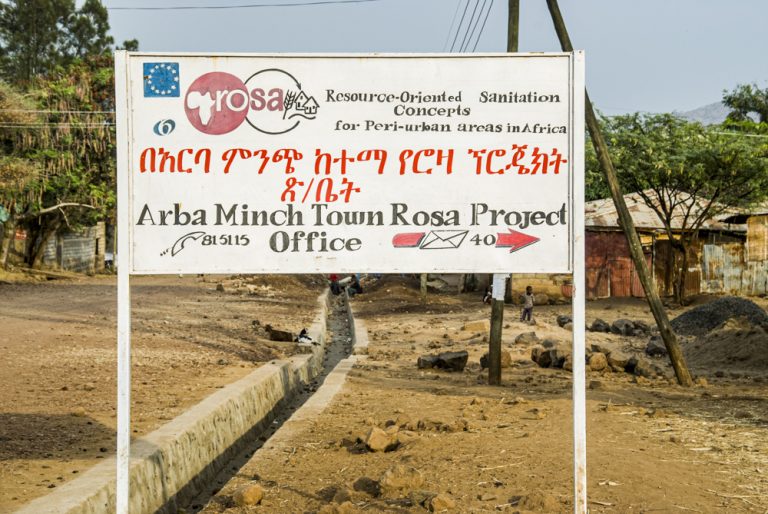Sustainable Sanitation in Ethiopia
Omo River Basin
|
NEW ESRI StoryMaps: What's On Our Shelves & NWNL Song Library & No Water No Life ESRI |
Omo River Basin
Fikre Assefa
Arba Minch University, Department of Water Resources and Irrigation Engineering
Alison M. Jones
NWNL Director and Photographer
All images © Alison M. Jones. All rights reserved.
After a NWNL Omo River Expedition in Ethiopia, Alison Jones visited Arba Minch 1) to interview Water Technology Institute [WTI] scientists focused on Ethiopia’s water resources and hydrologic projects; and to discuss her 100-page Proposed Management Plan for Nech Sar National Park with the current manager of that park. (The Plan is online as 16 MB PDF — or 4 MB PDF). Scientists there working on solutions in both the Blue Nile and Omo watersheds took us to a local model for SSS (Sustainable Sanitation Practice), a critical element of WASH (Water Availability, Sanitation and Hygiene). This pilot for study for ROSA (Resource-Oriented Sanitation concepts for peri-urban areas in Africa) was composting human, livestock and food waste for biogas usage, and looking forward to larger-scale implementations of sanitation planning.

Editors Update, 2018: Ten years after this interview, ROSA had implemented its sanitation solution, as described below, in four East African cities: Arba Minch, Ethiopia; Nakuru, Kenya; Arusha, Tanzania; and Kitgum, Uganda. This model for treating and safely using human excretia, grey water and solid waste successfully uses environmentally-sound urine-diversion Dry Toilets (UDDT) with locally available materials and simple methodologies. Citation: December 2018 presentation to the 34th WEDC International Conference by Shewa, Teklemariam, Meinzinger and Langergraber.

NWNL Fikre, thank you for driving me out to this project near Arba Minch, Ethiopia. You’ve described the evolution of ROSA’s effort to provide sanitation to rural areas in the vicinity of bigger towns. Now you’ve shown me how your small model can process human and cow dung with other waste to generate biogas. The biogas thus produced is then piped to a kitchen for cooking purposes.
You say that although biogas production can be expensive, this approach is cheaper since it doesn’t involve construction of large infrastructure. Thus, your model is easy for communities to adopt. Who is helping to develop this project and who is fiscally supporting this project?
FIKRE ASSEFA This system’s research is to find the exact ratio needed for human waste and cow dung waste, thus most of the people working on the project are scientists: sanitary or environmental engineers. Arba Minch University and Arba Minch Water Supply and Sewerage Enterprise are partners for this project. The ROSA project is supported by the European Union [EU], which is working on sanitation aspects.

NWNL What are the inputs used in this project? How many cows are involved? How many people? The local Arba Minch University has 10,000 students, so are they part input at this stage?
FIKRE ASSEFA We have around 10,000 people here – and that means there are a lot of cows, as well as a lot of food waste—and we are also planning to consider adding food waste to the compost.
NWNL Your goal is that this will eventually become a model for a bigger system. Do you expect that will be installed here at this university?
FIKRE ASSEFA Yes, because we constructed this after consultations with the management of the university. If this gets positive results and if the productivity of this is good, then we’ll have staff for this project. If we get positive reaction after we present the project to the university, the university will construct the structure. Thus far, the university has spent a lot of time and money for fuelwood and for construction for its cafeteria, as you can see. Now they are interested in this project and visiting the composting plant.
If this model is checked and gets an okay, the Arba Minch University would use this technology. The president is very happy on where we are going. ROSA’s objective is to teach the community and the university [about sustainable sanitation], since now the university is using a lot of resources for fuel wood from the forest.
NWNL May I ask what is this bubbling soil down besides your feet?
FIKRE ASSEFA This is sludge from post-production. The sludge comes out from that building, and we collect it here to dry, since it must be dry for transportation purposes. At that point, it’s taken to the composting site, and then mixed so it can be used again for composting. We’ve also tried planting some trees to grow here, like a ficus and a mango tree.

NWNL A grand, spreading mango tree – my favorite tree in Ethiopia. I hope that does well – in addition to this whole sanitation project!
FIKRE ASSEFA Yes. There is waste, and this waste has to be used. We must transition to using waste from our system – and be sure not to throw away any waste from the system. We are especially using cow dung and food waste for composting surplus. Here is the site where we first collect the wastes from the kitchen that we mix up with cow dung here in the basin.
NWNL Who is helping you with all of this?
FIKRE ASSEFA Actually, many are working in such environmental applications of composting. I have two assistants now and I will find others. One, who came from Germany as a student volunteer for the project, was here for two months with me. As well, there were about three staff in addition to me, totaling four staff in the project. We are working together, and now some of them are analyzing this sanitation plant for future applications.
NWNL Fikre, good luck with this very worthwhile project! I hope you succeed and become a model for the rest of Africa’s peri-urban communities.

Posted by NWNL on January 27, 2020.
Transcription edited and condensed for clarity by Alison M. Jones.
All images © Alison M. Jones. All rights reserved.
